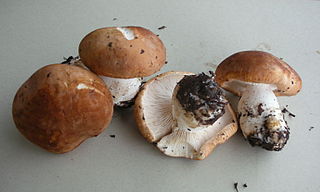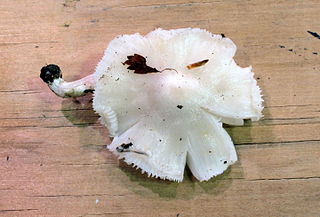Paracrangonyx is a genus of amphipods in the family Paracrangonyctidae, comprising two species, Paracrangonyx compactus and Paracrangonyz winterbourni.

Pleiospilos is a genus of succulent flowering plants of the family Aizoaceae. It is endemic to the Cape Provinces of South Africa. The name is derived from the Greek pleios "many" and spìlos "spot". The plants are also known as kwaggavy, lewerplant, lewervygie, klipplant, split rock or mimicry plant.

Clitocybe nebularis or Lepista nebularis, commonly known as the clouded agaric, cloudy clitocybe, or cloud funnel, is an abundant gilled fungus which appears both in conifer-dominated forests and broad-leaved woodland in Europe and North America. Appearing in Britain from mid to late autumn, it is edible, but may cause gastrointestinal issues.

The Gulf Coast kangaroo rat is a species of rodent in the family Heteromyidae found in Mexico and the state of Texas in the United States. Its appearance and ecology are very similar to those of its putative sister species, Ord's kangaroo rat.
Phlegmariurus compactus is a species of plant in the family Lycopodiaceae. It is endemic to Ecuador, where it is distributed throughout the southern Andean páramos. It occurs up to 4500 meters in altitude.

Erigeron compactus is a species of flowering plant in the family Asteraceae known by the common names cushion daisy, fernleaf fleabane, and compact daisy.

Leucopaxillus gentianeus is a bitter-tasting, inedible mushroom commonly known as the bitter false funnelcap, or the bitter brown leucopaxillus. A common synonym is Leucopaxillus amarus. The bitter taste is caused by a triterpene called cucurbitacin B. The species was first described in 1873 as Clitocybe gentianea by French mycologist Lucien Quélet. František Kotlaba transferred it to Leucopaxillus in 1966.

Aspropaxillus giganteus, also Leucopaxillus giganteus, commonly known as the giant leucopax or the giant funnel, is a saprobic species of fungus in the order Agaricales. As its common names imply, the fruit body, or mushroom, can become quite large—the cap reaches diameters of up to 50 cm (20 in). It has a white or pale cream cap, and is funnel-shaped when mature, with the gills running down the length of the stem. Considered by some to be a choice edible when young, this species has a cosmopolitan distribution, and is typically found growing in groups or rings in grassy pastures, roadside hedges, or woodland clearings. It has been shown to contain a bioactive compound with antibiotic properties.

Leucopaxillus albissimus, commonly known as the large white leucopaxillus, is a species of mushroom that lives as a saprobe, decaying the litter under coniferous trees. It produces a large white fruiting body that is unusually resistant to decay. It is considered to be inedible.
Herpestides is an extinct genus of terrestrial carnivore that was endemic to North Africa and Southern Europe during the Early Miocene subepoch and existed for approximately 2.4 million years.
Leucopaxillus is a species of fungus in the family Tricholomataceae, and the type species of the genus Leucopaxillus. It was first described as Clitocybe paradoxa in 1896, and transferred to the newly created Leucopaxillus in 1925. It is found in Asia, Europe, and North America.

Orthotylus is a genus of bugs from the family Miridae. There are more than 300 described species worldwide. The sheer number of species has led to the recognition of subgenera and groups, some of which may be promoted to genus level. Yamsunaga recognized the genus as non-monophyletic, and without consistent diagnostic characteristics.

Albomagister is a genus of fungi in the family Tricholomataceae. The genus contains just one named species known from Tennessee and North Carolina, however two other undescribed species have been sequenced. Albomagister was described by mycologists Marisol Sánchez-García, Joshua Birkebak & P. Brandon Matheny in 2014 with Albomagister subaustralis as the type species.
Dichostates compactus is a species of beetle in the family Cerambycidae. It was described by Fairmaire in 1887.

Xylosandrus compactus is a species of ambrosia beetle. Common names for this beetle include black twig borer, black coffee borer, black coffee twig borer and tea stem borer. The adult beetle is dark brown or black and inconspicuous; it bores into a twig of a host plant and lays its eggs, and the larvae create further tunnels through the plant tissues. These beetles are agricultural pests that damage the shoots of such crops as coffee, tea, cocoa and avocado.
Cyperus compactus is a sedge of the family Cyperaceae that is native to the South East Asia, Madagascar and northern Australia.
Rhytidoporus compactus is a species of burrowing bug in the family Cydnidae. It is found in Central America and North America.

Schoenus compactus is a species of sedge endemic to south-western South Africa.

Leucopaxillus alboalutaceus is a species of fungus belonging to the family Tricholomataceae.

Pleiospilos compactus, called living rock, is a species of flowering plant in the ice plant genus Pleiospilos, native to the southwestern Cape Provinces of South Africa. A succulent, it has gained the Royal Horticultural Society's Award of Garden Merit.













